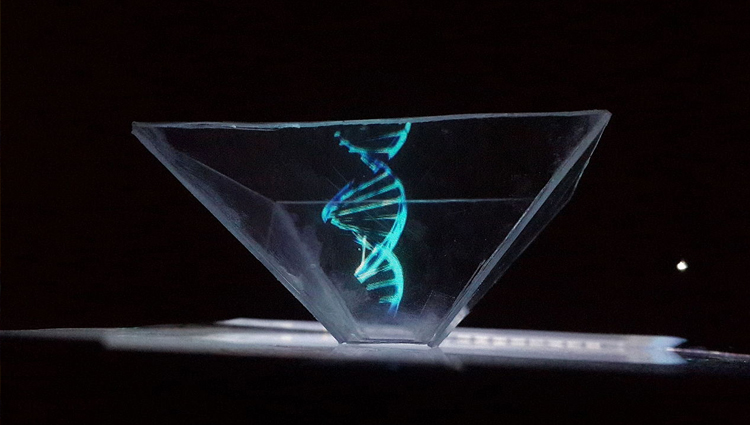Virtually Project Yourself In 3D
Materials science breakthrough leads to a new type of holographic display.
Image

Media credits
FLAGSTAFF, Ariz. (ISNS) -- In 1977, Star Wars introduced popular culture to holographic projections with Princess Leia's famous distress message to Obi-Wan Kenobi. Since then, countless science fiction films have recycled the idea by having characters project themselves via hologram. Now, a team of physicists at the University of Arizona has taken a step towards making it a reality.
The physicists claim that their holographic 3-D display can refresh color images every two seconds and say it's the closest thing to a real time holographic projection ever created.
“What we have come up with is a new technique to do three dimensional telepresence, which means that we can take objects from one location and show them in another location in 3-D,” said Nasser Peyghambarian, director of the National Science Foundation's Center for Integrated Access Networks.
Peyghambarian said that a movie like Avatar creates a 3-D image with just two different perspectives, or one for each eye. However, by surrounding an object with cameras in a semi-circle, this technology creates a multitude of perspectives in the display that allow the image to actually change as you move your head.
“You look at the display like you look at your computer screen, but if you shift around, you see a different perspective,” said Pierre-Alexandre Blanche, an assistant research professor at the University of Arizona in Tucson.
The breakthrough was possible because of a material called a photorefractive polymer film, on which a 3-D image can be recorded and erased, and then replaced with a new image in nearly real time.
“Polymers have existed for a long time, what's new is that we have refreshable material now,” said Blanche.
An image -- whether real or computer generated -- is recorded in the polymer by high energy lasers firing frequent pulses. As the laser's light is absorbed in the film, it modifies the film's optical properties and creates a 3-D image in high definition. Best of all, the process eliminates the need for silly glasses.
The hologram still exists inside of a flat frame rather than being projected into thin air, but like a sheet of magical glass it allows you to see all sides of an image as the frame is rotated. This sets it apart from seemingly 3-D projections like those used by CNN in its election night coverage, which still only show one perspective.
For now, the hologram is only about 4 square inches -- or as Peyghambarian said, about the size of the Princess Leia hologram, but the group plans to make a version that is large enough to be more useful. They have already demonstrated a prototype that is about a square foot and in the next few years they expect to have a 6-foot square screen that is capable of the same speed as video, has a higher resolution than even HDTV and can produce a wider range of color.
Michael Bove, who heads a media laboratory team at the Massachusetts Institute of Technology in Cambridge, Mass., is working on their own holographic video technology. They agree that such devices will soon be commercially available, but said it might not be this group's technology that makes it into the market. Bove compared holographic video to the early days of television, where many different approaches were competing to be accepted.
“I think there are a half dozen technologies that could have holographic video into people's living rooms in ten years,” Bove said. “What they've done is largely a materials science advance. There's nothing about their overall display architecture that makes it more suited (than other technologies) to do telepresence.”
But Blanche said that the device is a huge improvement over what they had before, which only allowed updated images every five or six minutes in a four inch frame. He added that achieving a video speed is a must before the technology can be widely marketed for entertainment and said it could also be used for things like telemedicine, advertising, manufacturing and military applications.
“In our everyday life we see hundreds of perspectives with our naked eye and this technology is the closest one to that,” said Peyghambarian. “We have demonstrated the concept that it works, so it's no longer something that is science fiction, it's actually something that you can do today.”
Filed under
